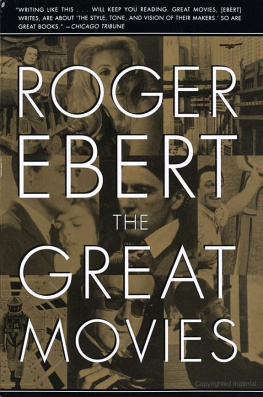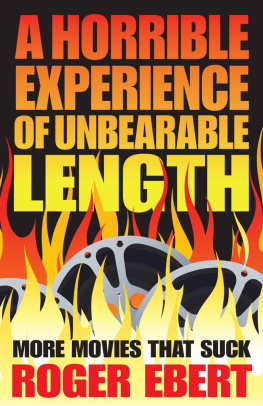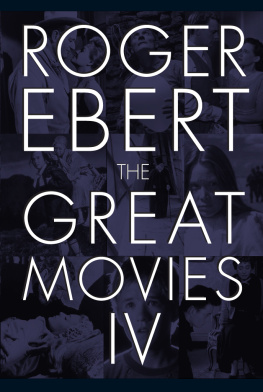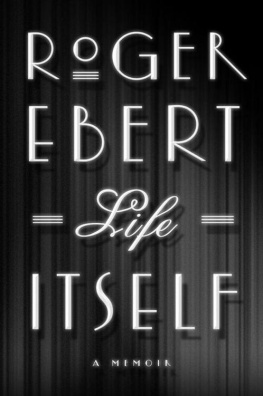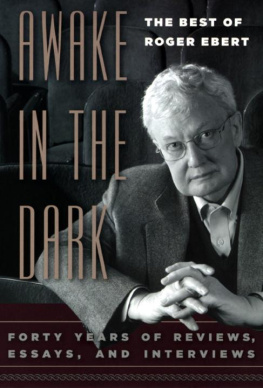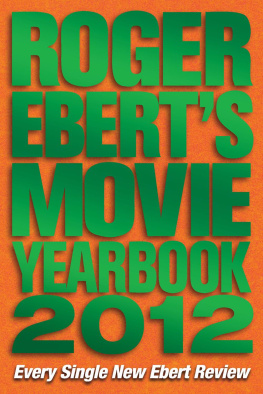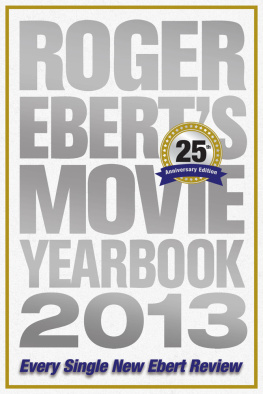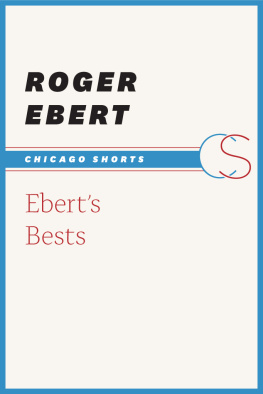

Other Books by Roger Ebert
An Illini Century
A Kiss Is Still a Kiss
Two Weeks in the Midday Sun: A Cannes Notebook
Behind the Phantoms Mask
Roger Eberts Little Movie Glossary
Roger Eberts Movie Home Companion annually 19861993
Roger Eberts Video Companion annually 19941998
Roger Eberts Movie Yearbook annually 1999
Questions for the Movie Answer Man
Roger Eberts Book of Film: An Anthology
Eberts Bigger Little Movie Glossary
I Hated, Hated, Hated This Movie
The Great Movies
The Great Movies II
With Daniel Curley
The Perfect London Walk
With Gene Siskel
The Future of the Movies: Interviews with Martin Scorsese, Steven Spielberg, and George Lucas
DVD Commentary Tracks
Beyond the Valley of the Dolls
Citizen Kane
Dark City
Casablanca
Floating Weeds
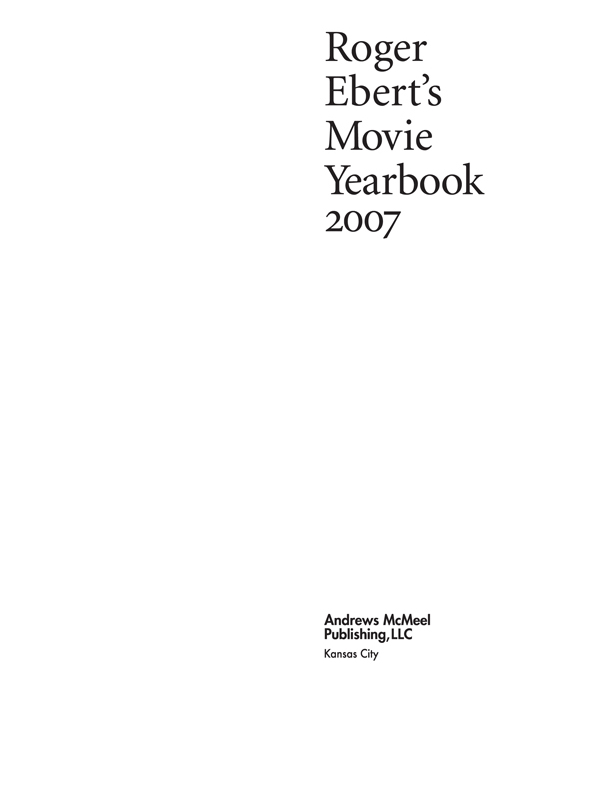
This book is dedicated to my Aunt Martha, who took me to the movies.
Contents
Introduction
In six decades there have been three revolutions in the way movies are distributed. The first was in 1948, when the Supreme Court found the big studios in violation of antitrust laws and ordered them to sell their theater chains. Until then, the majors owned theaters and booked their own movies into them; afterward, the playing field was more level for independent producers.
The second came when platforming was replaced by mass national bookings of major new films. For decades, a new film would open in a few big markets, typically New York and Los Angeles, and then trickle through to the rest of the country. This provided a way for audience word-of-mouth to spread and was a godsend for smaller films that needed time to win a reputation. Three films that especially benefited from platforming were Bonnie and Clyde , My Dinner with Andre , and Chariots of Fire .
That model changed when studios started using national TV ad campaigns for their movies. At about the same time, more movie stars became willing to appear on television; for years, many of them had refused. Now the pieces were in place for the modern system in which a big movie will open in thousands of theaters on the same day, backed by an advertising and publicity blitz.
A drawback of this model is that it is best suited to blockbuster films. The opening-night audience for a mass-market action picture is made up mostly of teenagers, who have free time; adults need more warning to gear up for a visit to the movies, and often the movie closes before they can get to it. This has created a loop in which more and more Hollywood movies are aimed at young action and comedy audiences. To some degree, the pattern has been offset by the rise of independent films and the theaters that show them, including the Landmark chain.
The third revolution is happening right now. It involves a fundamental shift in the medium chosen by moviegoers. The studios get more of their revenue from DVDs than from ticket sales, and if you consider that much of that revenue comes from rentals, its apparent that most people see more movies on DVD than in theaters. Sure, these movies would look better in a theater, but if they are getting to audiences that want to see them, thats a good thing. There are precedents. When Allen Lane introduced Penguin paperbacks, he was told he would destroy the book publishing industry. When the first Betamax home video machines came onto the market, the studios sued to block home videos, which would eventually earn them billions. If I were a director, I would prefer for my work to be seen in a theater but would be happy for it to find an audience anywhere. And the extras on DVDs now mean moviegoers can learn more about the making of a film than any one filmmaking professional used to know.
Movies also have a big presence on television, and the studios are correctly experimenting with technology that will allow viewers to rent movies on demand via cable, satellite, or the Internet. The danger of such digital distribution, from the studios point of view, is that movies in digital form are easier to pirate than those on 35 mm film. Thats one reason that digital projection, which was supposed to replace film in theaters, seems stalled (another is that no one wants to foot the $100,000 per booth price tag).
I believe that the best way to see a movie is in a theater with an audience, and that light-through-celluloid is still better than any digital projection system I have seen. But this is not the way most people now see movies, and there is a bright side to the digital revolution. Home video itself meant that for the first time viewers could program their own viewing; they were no longer at the mercy of theaters and TV stations. There has been a big jump in the quality of home entertainment systems (and a rapid fall in their prices), and it is no longer unusual for a consumer to have a big flat-screen or front-projection screen and a surround sound system. Movies shown on these systems look impressive when seen on high-quality DVDs and will look even better when HD-DVD comes in, although that switch has been stalled by a war between two formats.
Last year Steven Soderbergh, who makes both big commercial movies ( Oceans Eleven ) and small indie films ( Sex, Lies, and Videotape ) did some lateral thinking about the problem of distribution, especially for smaller films. It costs a fortune to open any first-run movie in New York City and, in a sense, if it hasnt made it there, it cant make it anywhere. But whats the point of producing a $100,000 movie when it costs more than that for an ad campaign in the New York Times ?
What Soderbergh tried with his film Bubble was revolutionary: He would release it more or less simultaneously in theaters, on DVD, and on pay cable. This strategy was not welcomed by theater owners, needless to say, but it had the advantage of concentrating all of the publicity and advertising efforts at one time. The heat generated in each medium would in theory help the film in the others.
At Cannes 2006 I ran into Jonathan Sehring, the inventive and risk-taking producer of nearly fifty independent pictures, many of them for IFC Films and its digital spin-off, InDiGent. He said the Soderbergh model seemed to hold hope for his kind of film, and he cited one title whose box office take went up 15 percent in New York in its second week, apparently because of word-of-mouth inspired by cable.
My guess is that theaters are wrong to oppose this form of distribution, which will apply mostly to smaller films. Although the window between theater and DVD has been growing smaller for all releases, it is probably true that for many more years big Hollywood movies like Superman Returns will open exclusively in theaters. But smaller indie films like Me and You and Everyone We Know , The Proposition , LEnfant , and Water could benefit from cross-platform openings.
Moviegoers know that all movies will eventually be on DVD; they choose to go to theaters because they like that experience, but they cant see every film that way. Imagine a scenario in which Landmark, say, sells DVDs in its lobby. A hypothetical customer buys a ticket to Lonesome Jim , and on the way out runs into friends who have just liked The Notorious Bettie Page . On an impulse, he might buy the Bettie Page DVD. If theaters limited themselves to movies currently in release, it wouldnt involve a lot of inventory and sales space; it would be more like the CDs displayed at Starbucks.
Next page

